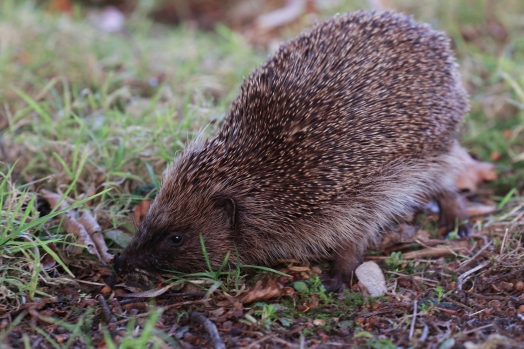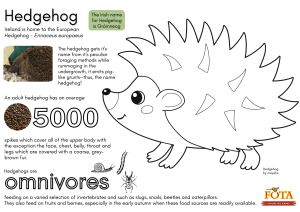Tomorrow, February 2nd, is Hedgehog day. Soon you may spot one of Ireland’s most distinctive mammals, as the hedgehog will awaken from its winter slumber.
The hedgehog was named because of its peculiar foraging methods while rummaging in the undergrowth, it emits pig-like grunts—thus, the name hedgehog!
The hedgehog’s main line of defence is the possession of spikes which cover all of the upper body with the exception the face, chest, belly, throat and legs which are covered with a coarse, grey-brown fur. An adult hedgehog possesses an average of 5000 spikes.
The hedgehog is described as being omnivorous, feeding on a varied selection of invertebrates and such as slugs, snails, beetles and caterpillars. They also feed on fruits and berries, especially in the early autumn when these food sources are readily available.
Hedgehogs typically breed between March and October. After a gestation period of about 32 days, three to five hoglets are born! All wild hedgehogs can hibernate, though not all do, depending on temperature, species, and abundance of food.
Hedgehogs can be of great benefit to both gardeners and farmers alike. Its preferred diet of slugs and snails reduces the need to use synthetic pesticides. However, deaths from poisonings are well documented as the hedgehog feeds on a large variety of pest species resulting in prolonged exposure to toxic chemicals and inevitably death. Despite being afforded legal protection (Irish Wildlife Act 1976 / 2000 & Bern Convention Appendix III), changing land use practices coupled with road construction and increased levels of traffic has meant that hedgehog populations have begun to decline.

There are some 15 species of hedgehog in Europe, Asia, and Africa. Hedgehogs have also been introduced into non-traditional ranges such as New Zealand. The Irish name for Hedgehog is Gráinneog.
If attacked they will curl into a prickly and unappetizing ball that deters most predators with the exception of the badger and a selection of birds of prey. They usually sleep in this position during the day and awaken to search for food at night.
What can you do at home to benefit hedgehogs?
To help encourage and protect these welcome garden visitors –
- Avoid interfering with hedgehog nests which are often located in hedgerows, compost heaps and leaf litter.
- Avoid the use of slug pellets and pesticides in your garden
- You can offer hedgehogs an overwintering site by providing a pile of hay, leaves or straw under a dry shed or log pile
Are you a teacher or parent looking for an activity for Hedgehog Day?
We’ve put together some of the above into a simple colouring sheet activity that you can download below.
Be sure to check out all our learn from home resources here.
Photo credit – Henry O’Brien












